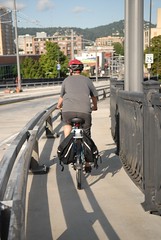
Bridge sidewalk (view is facing
west on the north side of the
bridge).
(Photos © J. Maus)
TriMet recently completed a construction project on the Steel Bridge and the result is a narrower sidewalk on the north side.
The majority of people that ride bikes over the Steel Bridge use the shared, non-motorized vehicle pathway on the lower deck, but the upper deck is still an important connection for some. When headed eastbound, I prefer to use the upper, bridge sidewalk because it is more direct and quicker for me than taking the lower-deck and then connecting to the Esplanade.
During the morning commute, I still often see people on bikes use the westbound sidewalk. But with the newly narrowed sidewalk, TriMet is urging extra caution and has posted an alert notice that states, “The optimal route for pedestrians and cyclists remains the lower deck of the bridge.”
TriMet created a map of these “Vehicle Access Changes” (unfortunately it doesn’t mention bicycles):
In addition to recommending the lower deck, TriMet has added a new sign to the bridge and is also reminding bike operators to yield to pedestrians.
I went out to the location today to check things out.
The northern sidewalk begins to get narrower as it heads downhill on the west side of the bridge. It also narrows right at a corner where visibility is limited. It is still passable via bicycle, but it is indeed an area that requires slow speeds and a lot of caution.


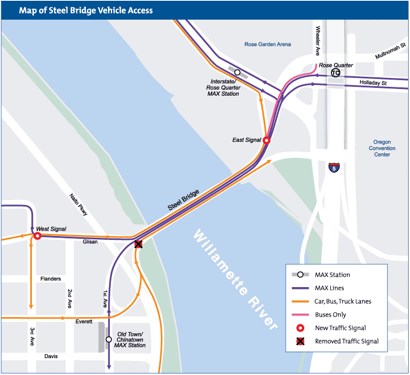
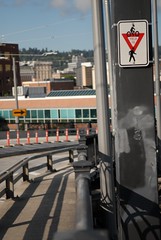
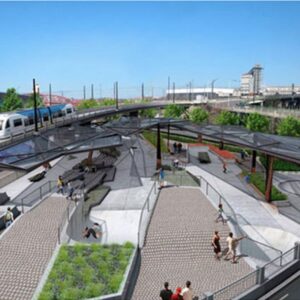
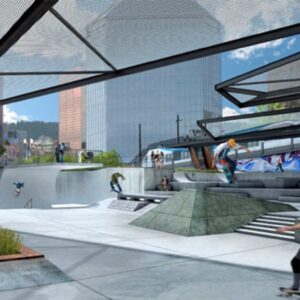
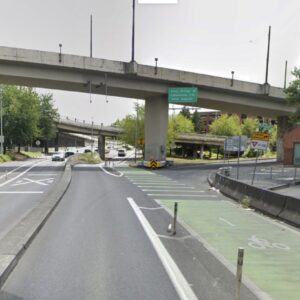

Thanks for reading.
BikePortland has served this community with independent community journalism since 2005. We rely on subscriptions from readers like you to survive. Your financial support is vital in keeping this valuable resource alive and well.
Please subscribe today to strengthen and expand our work.
the best place to ride on the upper deck of the Steel Bridge is on the road in the lane, not on the sidewalk.
Is there a one-way restriction (like on Hawthorne–north side=Westbound, south side=eastbound) for bicycles on the upper deck of the Steel Bridge?
That sidewalk was sketchy enough before. If I ride across the top, I ride in the lane. It\’s way better than the sidewalk. Just ride fast!!!
This will encourage some cyclists to ride the auto lane across the bridge. The steel grading is paved so it’s easy to ride but the motorized traffic is not expecting slow moving vehicles as they crest the bridge span. I’ve taken this route –and wouldn’t recommend it- but as walkers and bike riders increase in numbers, more bicyclists will begin to take the auto traffic lane.
wow. I\’m surprised to hear that some of you take the lane on the bridge. I consider myself a pretty \”strong and fearless\” type of rider, but I don\’t think I\’ve ever done that.
I\’ll have to take a second look… but it seems like it\’d be very uncomfortable (notice I said uncomfortable, not unsafe) to ride in the roadway up there.
I\’ve never thought to take the lane just as I\’ve not considered it on the Broadway.
I\’m never in such a hurry that the sometimes slow nature of crossing along the lower deck is problematic. In fact, one of the many reasons I opt for two wheels is to slow down and enjoy the moment. Even at a pure walking pace, we\’re talking what… 3 minutes?
I see a looming issue as ridership increases. During high (cyclist) traffic, it\’s easy to imagine completely stopped traffic on the lower deck. All you need is a stream of pedestrians without significant gaps. Add a few hundred bikes and we\’ll be queued up on either side, walking. If/when that happens, I\’ll be much more interested in popping onto the upper deck.
When the day comes when there are cyclist bottlenecks on the lower deck, I trust that Sam will step up and push for a fair cost-effective solution. Without being a traffic engineer, I would imagine sharrows on the roadway to be an option to consider.
This is disappointing. I have encountered at least one instance where the lower crossing was closed and I had to double-back and cross on the upper deck.
I just hate seeing \”improvements\” that make things more difficult for bicycles.
I believe there is a \”Bikes on Roadway\” sign on the upper steel bridge.
\”I believe there is a \”Bikes on Roadway\” sign on the upper steel bridge.\”
yep. there is. forgot to snap a photo this morning, but it was definitely there.
I find that sign very interesting in this context and there\’s also one placed at the entrance to the St. Johns Bridge.
In both cases, there is no shoulder or specific facility for a bike on the road, and the sidewalk is not technically wide enough to be a \”shared-use path\”.
Because of that, I wonder if technically and legally, the recommended route is to ride on the roadway. I need to ask about this.
And when on the grating in the lane of the upper deck, be sure to get out in the middle of the lane.
Don\’t let anyone think they are going to squeeze by you in the narrow area.
Once it becomes necessary to take the lane you are on the flat and can get up to 20 mph fairly easily. The auto traffic doesn\’t seem to mind that speed because they don\’t like the grating either.
How about expanding the lower deck to have bike lanes for either direction and also a pedestrian lane.
I\’ll take that sidewalk when I\’m heading east and the lower walk is raised. I\’ll run up the stairs and jump back on the bike on the walkway.
Can\’t remember off hand, but I think that at the top of the stairs, the railway is a decent impediment to safely getting onto the roadway. For as rarely as I take that walkway, I\’ll just stick to that.
wow. I\’m surprised to hear that some of you take the lane on the bridge. I consider myself a pretty \”strong and fearless\” type of rider, but I don\’t think I\’ve ever done that.
I\’ll have to take a second look… but it seems like it\’d be very uncomfortable (notice I said uncomfortable, not unsafe) to ride in the roadway up there.
I\’ve never ridden the sidewalk on this bridge, it was too narrow before this recent work.
The lane is pretty narrow also, you just ride in the middle, and there\’s no passing. Also, this bridge is not that long.
Maybe the top deck should be marked with \”sharrows\”?
It might be too narrow for kid trailers.
It is too bad because I found the lower deck closed a bunch of times and had to navigate the top and with a trailer it was not very easy.
Thanks for reporting, I will avoid it if possible, or drive……
Ive found the lower deck to be very crowded with pedestrians. I guess of all problems to have this isnt necessarily a bad one, but a bit annoying when I just want to get back on the street and start going again.
Im glad the upper deck is open again, I have yet to take the lane, but probably will avoid the lane with metal grate is its wet out.
maybe they should just close this bridge completely to private motor vehicles?
a few thoughts.
yes, even before this project the sidewalks are extremely narrow.
towing a trailer or other wide loads are not recommended.
I like the sharrow idea (both here and on St. Johns!)… i need to find out the latest with those.
As for taking the lane… sounds like possibly a group ride is in order to show folks this route and help calm fears around it?
anyone want to organize?
The lower deck gets me to my daily destination, so I don\’t top this bridge much but I do take the lane when I do.
My dad used to be the trainmaster at the UP yards and in his Omaha retirement he still asks me about this bridge when we chat.
With passenger rail, cargo rail, ped, bike, max, bus, streetcar, and auto traffic, this is one of the most multimodal bridges in the world.
It is also the only double lift bridge with independent lifts in the world, if memory serves me right. And the oldest vertical lift bridge in the country, next to the Hawthorne.
My kids just took Amtrak to Albany and upon arriving home jetted to their bedroom to make their very own Steel Bridge. \”We rode on the same level you ride your bike, dad!\”
My favorite aspect is when Max is crossing the top deck and there\’s nothing on the lower deck, you can get the impression that you\’re being passed by an imaginary line of rail traffic.
\”Any ghost trains today, Dad?\” is a common first question when I get home.
Anyway, I love this bridge.
As you were.
are the lanes wider then with the shrinking of the sidewalk?
It is amazing that this work has been allowed to narrow the already shockingly ineffective sidewalks on the bridge.
Once again a sign that grotesquely huge and inefficient Tri Met expenditures are more important than the safety of vulnerable road users, in the eyes of TriMet, the City, and the Depts. of Transportation.
Having a redundant Light Rail system is ludicrous enough at best, and once again \”fixing\” the Steel Bridge to accommodate such is happening at the price of vulnerable road users (how any times in the recent past has the Steel been retrofitted for the Max? Quite a few)
I for one ride the road across it whenever needed, but I do not recommend it for any more than the most experienced riders, and it is irresponsible for Tri Met to be allowed to narrow the only really safe route across the top of the bridge.
Rant Over, cross at your own risk!
Jonathan,
I have actually contacted PDOT about sharrows on the St. John\’s bridge and they claim to have forwarded my concerns re. crossing the bridge and the sharrow marking idea to ODOT, who actually \”owns\” the bridge. I hold little hope. Who \”owns\” the Steel Bridge?
I agree that the bridge could benefit from sharrows. The street connections from the lower section are awkward so I don\’t like taking the lower section.
Hardly something to get excited about. There are plenty of safer and equally convenient ways to cross the river.
depends where you\’re going
\”Who \”owns\” the Steel Bridge?\”
I believe the Union Pacific Railroad company owns it.
@26
Uncle Pete does indeed, I believe, actually own the Steel, a bridge they constructed in the Long Ago.
The upper deck, I think, is leased to ODOT and they sublease a right of way to Tri-Met.
So you can hop a freight, break a speed limit or skip a fare and be under the juristiction of any number of five-oh, all without leaving the confines of one very cool engineering feat.
When I was commuting from North I frequently took the lane moving east to west. The lane is by no means ideal, but I found it to be less sketchy than the sidewalk. In my experience there were (and are) three primary issues: the sidewalk is unusually narrow to begin with. If you confront a pedestrian you really have to slow to a crawl. And then the transition from sidewalk to lane at the west base of the bridge is problematic at best, dangerous at worst.
In assessing the relative bike-friendliness of the detour down to the Esplanade, I apply my personal rule of thumb: whether we would subject motorists to the same kind of conditions. Answer: No.
So I agree with Jonathan that it\’s a substandard situation. It\’s one of a few thousand situations that need to improve before Portland can legitimately be considered on par with the world-class Euro cities.
Given today\’s conditions, my recommendation is for the confident rider to take the lane moving east to west.
Maybe someone should just spray in the sharrow symbol on their own. Or is that the moral equivalent of selling meth to 8-year-olds?
@#\’s 19 & 27
Donald… you a funny cat for snaking all that info from here.
The upper deck sidewalk is NOT even close to being a significant bike route. This project has little to no effect on bicycles. The lower deck works quite well for bicycle traffic now, provided cyclists can handle a slower speed, as they would on any sidewalk. Given the development of the lower deck\’s multi-use path which is far wider than the upper level sidewalks ever were, I find this issue moot. Lastly, blaming TriMet (as comment #28 did) for sidewalk deficiencies on a 100+ year old bridge is ridiculous. TriMet didn\’t construct the bridge, nor owns it.
Maybe someone should just spray in the sharrow symbol on their own.
OMG! Grafitti!
If the city doesn\’t do it themselves soon, I\’m in…
🙂
The \”Bikes on Roadway\” sign reminds me of an odd sign on the Morrison. Despite the fact that there is no way for a bicycle to legally get on the Morrison Bridge (correct me if I\’m wrong; I\’d love to know of a legal way on), there is still a sign warning bicycles, not motorcycles of the dangers of the expansion joints, I believe.
The bridge is currently owned by Union Pacific with the upper deck leased to Oregon Department of Transportation, and subleased to TriMet, although the City of Portland is responsible for the approaches.
John – Despite the fact that Multnomah County has \’no bikes\’ signs posted at either end of the Morrison Bridge, most of the bridge is considered a local street, open to bikes. The only portions of the bridge that are legally closed to bikes are the I-5 entrance and exit ramps.
Adam (#11) – expanding the lower deck isn\’t practical. To do that, someone would need to pay for an engineering study. Union Pacific Railroad, the owner of the bridge, would need to approve the changes – which would involve adding an equal weight to the other (north) side of the bridge and additional weights on the bridge counterweights. The changes would likely require approval at the county and state level, and the bridge would need to be closed to river traffic, lower and upper deck traffic a number of times for the installation of those weights, counterweights, and testing of the lift capacity of the bridge.
It\’s also possible that the installation wouldn\’t be able to be done if the weight was significant enough – the current catwalk was possible because the motors, pulleys, cables and counterweights had excess capacity – the bridge needs to maintain a certain safety factor in terms of the amount of weight those components carry – which also affects the frequency of inspections, etc. All of this costs money, and the complete approval process would almost certainly take at least 2 years, and probably closer to 3-5.
Jonathan (#26) – You are correct, UPRR owns the bridge and allows Tri-Met and the county to operate over it.
BURR (#35) – What do you base your interpretation on? ORS permits local jurisdictions to prohibit bike access, so unless the county did not follow proper procedures, they are legally empowered to restrict bike traffic across the bridge. If one of the attorneys on the list knows different, would you please care to correct me / enlighten us?
I take the Steel Bridge going West to East in the evenings. When the bridge was closed, I was forced to use the lower deck, which is terrible because it is about 6-inches wide and there are too many people (bicyclists, pedestrians, joggers) using the bridge for people to get across effectively.
Now that it is open, I am back to riding on the upper deck, on the sidewalk. I only encounter maybe one person per week that I call out \”coming up behind you\”. They move over, I say Thank You, and everything is good. If there were a lot of people up there, then I would ride on the roadway.
People like the path of least resistance, even if it is less safe. So unless somone wants to pay to expand the lower deck to better accomodate all users, then people will use the road/sidewalk of the upper deck.
Pick your battles,
1. The lower bike/pedestrian path on the steel bridge is pretty damn cool. A couple million was spent to make it accessible.
2. The refit on the Broadway and hawthorn bridges drastically improved bike access and safety across the river.
Not every bridge needs to be 100% bike, pedestrian or equestrian compatible when there are reasonable alternatives. I see the point for sharrows on the Saint Johns or adding a bike lane across the north Portland railroad bridge, but asking for more on the Steel just seems greedy.
Be measured and reasonable in your requests and you will be taken seriously. Ask for everything and the moon and you will be marginalized.
I guess I didn\’t realize it would be ok for us to ride on the sidewalk on the top. I take the bridge often to work. I often use the lower section to cross but do us the lane when on top. Since we are talking about bridges what is the proper way to cross the Sellwood. I\’ve tried the sidewalk there a couple of times but don\’t like squeezing the walkers so started taking the lane there. I haven\’t had any issues on the Sellwood, but it is sort of scary during rush hour.
Jonathan #5 said:
The upper deck has been my preferred route to work in the morning for a number of years. I find it to be more direct, faster, and more enjoyable than detouring through the switchback down to the lower deck.
I have had a couple of occasions where drivers have gotten upset when they discovered me using the lane at the crest of the bridge approach ramp. I have pointed to the \”Bicycles on Bridge Roadway\” sign to defend my presence there.
Once on the flat portion of the bridge, I almost always merge into the left hand lane so auto traffic can go by me. Now, however, that is not possible because they have poured a new curb there.
Also… RE: the above comments about steel grating on this bridge. There is none. There is some steel diamond plate plate on the sidewalk portion, but no steel grate anywhere. In fact, the main roadway has been improved quite a bit with a fresh new coat of asphalt. Yay!
My 2 Cents.
Kevin (#39) – the \”proper\” way to cross the Sellwood is on the road surface – the Sellwood even has \”bikes on roadway\” signs. If you pedal fast and it isn\’t rush hour, you generally will not get honked at nor passed too closely. If it\’s rush hour all bets are off. Another \”proper\” way is to walk your bike across the bridge on the sidewalk. (that will take a while)
There\’s no prohibition of bikes on the sidewalk, however – just be aware that you are required to yield to pedestrians. Most of the peds are polite and understanding, especially if you stop before reaching them and let them walk around you while you\’re stopped. They totally know how much the bridge sucks, and if you extend a little more courtesy than is required by law, you\’ll get the same courtesy in kind.
The first time I crossed the Sellwood, I did it on the sidewalk – I\’m actually more comfortable duking it out with the traffic on the bridge deck. The sidewalk has a LARGE dropoff to the bridge deck if you screw up, and it\’s not an especially WIDE sidewalk, especially around the light poles.
Joe (#31) – minor nitpick: The Steel bridge isn\’t \”100+\” years old – only 96.
That said, it\’s in remarkably good condition considering steel structures of its size were unknown before 1889, only 33 years before the construction of the Steel Bridge.
This story exaggerates the change:
Only the corner is changed, not the entire length of the bridge\’s sidewalk.
Further, I think the corner is *improved* from before– it\’s an easier turn ride down.
So far I\’m alright with the modifications, we\’ll see how I feel in a couple months…
I\’m like Tony T. If I\’m heading home to NE, I ride the lower deck, but take the upper deck if the bridge is being raised. I\’ve been using this bridge since April when I switched jobs and I don\’t find it to be a hassle crossing with any other traffic.
This past month was the only time crossing the bridge was significantly slower. However,that was due to the fact that many Tri-Met users were walking across the bridge to avoid the 30-40 minute trip that would take them by bus from Old Town to the Rose Quarter. Now that construction complete ped traffic is pretty sparse.